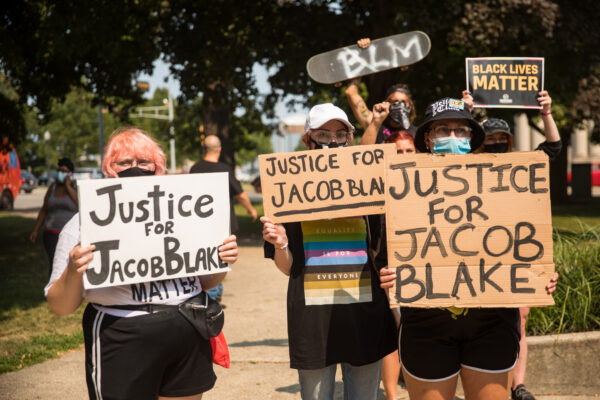By Rachael Meixensperger, ACLU of Wisconsin intern
In August 2020, Officer Rusten Sheskey of the Kenosha Police Department shot Jacob Blake, a Black man, seven times at close-range, paralyzing him, as Blake was walking away from Sheskey toward a vehicle where his two young children sat. This act of police brutality and excessive force demonstrates the continuation of trauma and violence against people of color in Kenosha and the country as a whole. In the wake of the murder of George Floyd, this shooting sent shockwaves throughout the community and prompted protests that called for police accountability, including an NBA playoff protest led by the Milwaukee Bucks.
Despite the response of the community, Officer Sheskey returned to work on March 31, 2021. Sheskey was not charged or subject to discipline. When questioned about this, Chief Daniel Miskinis stated that an outside agency was in charge of the investigation that found Sheskey acted within the law. There were no body cameras on the officers during the shooting. This event, and countless others like it, demonstrate the urgent need for discussion and action surrounding the lack of accountability for law enforcement officers.
Black people have undergone police violence throughout history. For young men of color, police violence is a leading cause of death. Black people are 3 times more likely to be killed by police, and 1.3 times more likely to be unarmed than white people. Police have killed people of color at alarming rates in the United States and must be held accountable for their actions.
Many tactics are currently used to ensure police officers are not held accountable. First, police departments often work closely with prosecutors, which places pressure on prosecutors to comply with officers. Questioning officers creates tension and a reluctance from prosecutors to critically investigate officers.
Second, contractual and legislative protections, including the bargaining power of police unions, work to protect and defend officers in case of any wrongdoing. For example, union-mandated appeals often reinstate police officers who have been fired. ‘Purge clauses,” after two to five years, require the removal of officers' disciplinary action records. This can make it more difficult to recognize possible patterns of misconduct.
Another tactic used is qualified immunity. Qualified immunity protects police officers from being held accountable unless they violated a clearly established constitutional right. All of these tactics used in tandem protect police officers, even in the case of wrongdoing.
Systemic racism and police violence harm communities of color. The American Public Health Association has named police violence as a public health issue and indicates that the following actions that must be taken:
- implement accountability measures for law enforcement officials
- eliminate formal and informal policies and practices that enable continued violence against populations of color
- invest in communities of color, and document contact, injuries, and police violence.
These recommendations aim to build and heal communities of color through police accountability.
The continuation of police violence targeting people of color must end. Policies and practices that protect police officers even in the case of wrongdoing must be abolished. We must instead prioritize investing in communities of color to promote healing and growth.

